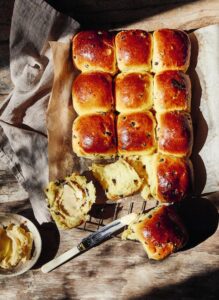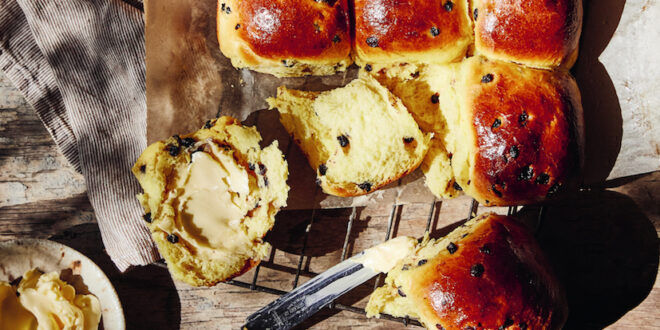Recipe courtesy of Around the Table by Julia Busuttil Nishimura, Macmillan Publishers, RRP $49.99
Inspired by Cornish saffron and currant buns, these buns not only look beautiful, but are so delicious. The rich brioche dough is also combined with tangzhong, which I usually use when making shokupan. The simple water roux, or in this case, milk roux, ensures the buns stay incredibly light. I like to make these buns around Easter time, in lieu of traditional hot-cross buns. I love their golden colour, thanks to the ever-so-elegant saffron. These buns are best eaten fresh on the day they are made. Alternatively, split open day-old buns and toast them before eating.
 MAKES 12
MAKES 12
Ingredients
- 0.3 g saffron threads (a good pinch)
- 100 g caster sugar
- 400 g plain flour, plus extra if needed
- 10 g active dried yeast
- 8 g fine salt
- 6 eggs (5 for dough, 1 for egg wash)
- 130 g unsalted butter, softened
- 100 g currants zest of 1 orange
TANGZHONG
- 60 g plain flour
100 ml full-cream milk
SUGAR SYRUP
- 50 g caster sugar
Method
Begin by making the tangzhong (milk roux). Whisk the flour and milk together in a small saucepan, then place over medium heat. Stir constantly for about 2 minutes, until there is no white-coloured paste remaining and it is a gel-like consistency. Transfer to a small bowl and allow to cool briefly.
Using a mortar and pestle, grind the saffron threads with 1 teaspoon of the caster sugar to form a powder.
Place the remaining sugar, the flour, yeast, salt, the five eggs and the saffron powder in the large bowl of a stand mixer fitted with the dough hook attachment. Add the tangzhong in pieces. Mix on low speed for 1–2 minutes, until it forms a shaggy dough. Increase the speed to medium–low and mix for 12–13 minutes, scraping down the side of the bowl every 4–5 minutes. It should be still quite soft, but not overly sticky now.
Add the butter, a tablespoon at a time, mixing well between each addition. This will take 6–7 minutes. Mix the dough for a further 4–5 minutes, until the dough is shiny, elastic and coming away from the side of the bowl.
Stop the mixer and lift up the arm. Take a little piece of the dough and stretch it out between your hands. You should be able to stretch it without tearing until it’s almost transparent enough to let light in. This is called the windowpane method and it’s a good way to see if enough gluten has developed in the dough. Continue mixing and checking until you can create a ‘windowpane’ successfully.
Add the currants and orange zest and mix briefly until just incorporated.
Transfer the dough to a lightly buttered large bowl and fold the dough in on itself a few times to create a smooth ball. Cover and allow the dough to rest in a warm place for about 1 hour, until doubled in size.
Grease a 33 cm × 23 cm × 5 cm rectangular cake tin with butter and line with baking paper.
Knock back the dough and tip it onto a work surface. Divide the dough into 12 pieces, around 90 g each, then roll the pieces into balls by tucking the edges into the centre, then turning over and rolling on the work surface with your hand in a circular motion. While you shouldn’t need to, if the dough is too sticky you can sprinkle it with a little flour, but avoid using too much as the friction of the dough on the work surface is necessary to create a smooth ball. Place the dough balls in the prepared tin with 1 cm of space between each ball to allow for rising and spreading. Cover and set aside to rise for 1 hour, until doubled in size.
After 30 minutes, preheat the oven to 180°C.
Whisk the remaining egg with 1 teaspoon of water and brush the buns with the egg wash. Transfer to the oven and bake for 20–25 minutes, until golden and risen.
To make the sugar syrup, combine the sugar and 2 1⁄2 tablespoons (50 ml) of water in a small saucepan over medium heat and stir to dissolve the sugar. Allow to simmer for 1–2 minutes, until ever-so- slightly thickened. Brush the syrup over the buns as soon as they come out of the oven. Allow to cool briefly, then serve.










Join the Discussion
Type out your comment here:
You must be logged in to post a comment.